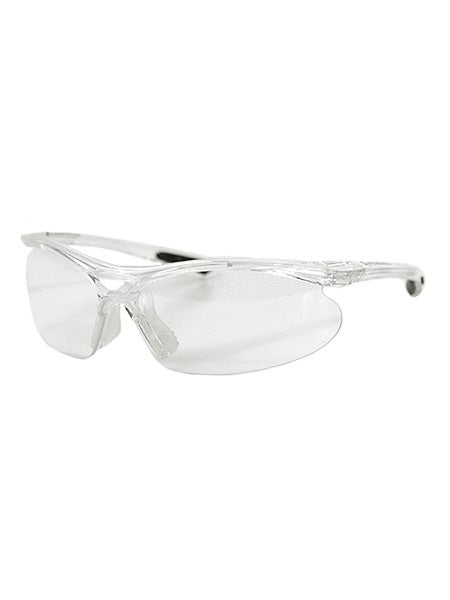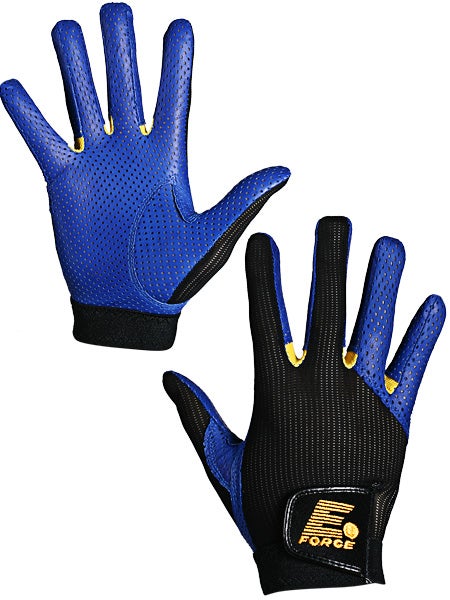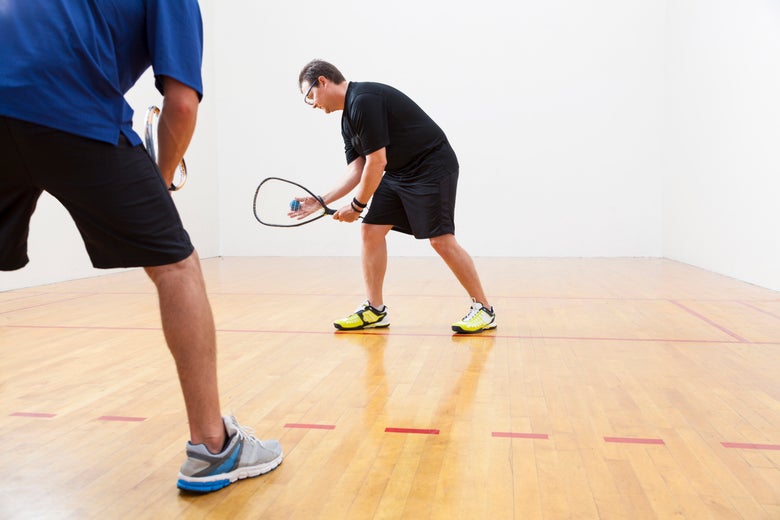How to Play Racquetball: Rules, Court & Equipment Explained
Racquetball is a fast-paced, competitive, and exciting sport that can provide a great workout and hours of fun for you and a partner or group of friends. Having been open for over 20 years, our staff at Racquetball Warehouse have helped thousands of beginners learn how to play racquetball.
If you’re interested in learning how to play racquetball, follow along as we explain the rules of the game, how a racquetball court is set up, and the equipment you’ll need to start playing!
Guide Contents
Click the sections below to jump to the info you need!
How to Play Racquetball: Simplified Objective, Scoring, & Rules
According to the United States Racquetball Association (National Governing Body for the sport of racquetball), the simplified objective of racquetball is:
“Racquetball is a competitive game in which each player/team uses a strung racquet to take turns at serving and returning the ball within a closed court.
The objective is to win each rally by serving or returning the ball, so the opponent is unable to keep the ball in play. A rally is over when a player is unable to hit the ball before it touches the floor twice, is unable to return the ball in such a manner that it touches the front wall before it touches the floor, or when a hinder is called.
Points are scored only by the serving side when it serves an irretrievable serve (an ace) or else wins a rally. Losing the serve is called a side out in singles. A match is won by the first side winning two games. The first two games of a match are played to 15 points. If each side wins one game, then a tiebreaker game is played to 11 points.”
To get a better understanding of a standard racquetball game, here’s an overview of how a game starts, is scored, and ends:
- Establish the rules and scoring -Traditionally, Racquetball is played to a score of 15 but some players prefer a longer game to 21 or a shorter game to 7.
- Serve the ball - Whoever is designated to start the game will serve the ball. The most basic rules for serving are that the server must be in the service zone, must allow the ball to bounce once off the court floor before hitting the ball, and the ball must hit the front wall first. The ball can hit any other wall after the front wall once and it must land in between the short line (Back of the service box) and back wall in order for it to be a good or valid serve. The server’s opponent or returning player must stay behind the receiving line until the served ball crosses the short line.
- Rally & keep score – If the serve is good then the opponent must return the ball before it bounces twice on the court floor. The opponent must return the ball so that it hits the front wall, but unlike a serve, the ball can hit any wall before hitting the front wall. The person who served now must return the opponent's hit using the same rules. Players alternate hitting the ball according to their turn, which is called a rally. A point is rewarded to whichever player can make their opponent unable to return the ball, but it should be noted that you must have served to be awarded a point. If the player that did not serve wins the rally, then they get to serve next, which gives them the opportunity to score a point.
- Game ends, next game begins – Whichever player is able to reach 15 points first wins the game. Racquetball is typically based on a best of three games, or five games set to determine the match winner. The first two games in a three-game set are played to 15, and if a tie breaker is needed, the game is played to 11.
This is a basic overview but there is a lot more to the rules than meets the eye, so for those wanting to play racquetball properly, follow along as we cover game rules in greater detail. To get a full understanding of racquetball rules, it is important to first understand how the court is set up and what the various lines on the floor of a racquetball court represent.
Racquetball Court & Floor Lines Explained
Standard racquetball is played on rectangular courts that measure 20 feet wide, 40 feet long, and 20 feet high, but not all courts are built according to these dimensions. The back wall of the court is often made of glass or another transparent material, whereas all other walls are typically non-transparent solid material.
Racquetball court lines
There are several lines on a racquetball court that designate different areas and help establish the rules of the game. While the court lines may seem confusing at first, they become easy to understand once you start playing.
Service Line, Short Line, & Service Zone
The service line is located 15 feet from the front wall. The short line is located 20 feet away from the back wall. These two lines are 5 feet apart from each other and have line edges on the sides. These side edges, the service line, and short line create a rectangular box called the service zone. Inside the service zone is where the server must stand to serve the ball.
Receiving Line
The receiving line is parallel to the short line and is located 15 feet from the back wall, indicating the area where the receiver must stay behind to receive the serve.
Drive Serve Line or Screen Line & Doubles Line or Doubles Box
On both sides of the service zone, you will see the drive serve line or screen line and the doubles line or the doubles box. The drive serve line is three feet away from the walls and 18 inches away from the doubles line. The doubles line is closest to the sidewalls of the court (Also 18 inches away). The doubles box is where the server’s teammate must stand in a double's racquetball game during a serve.
The drive serve line or screen line is a more specialized line for intermediate – advanced players. The purpose of the drive serve line is to give the non-serving player a better opportunity to return a drive serve. Drive serves can be hard to return since the purpose for the server is to hit the ball as low and hard as possible. When a person is hitting a drive serve, the racquet cannot cross the screen line, otherwise this is a fault. Once you are ready to try out a drive serve, be sure to watch our video about the rules for hitting a drive serve to get the full picture on this popular racquetball serve.
As you can see, racquetball court lines are not as complicated as they may seem at first glance. They will make more sense once we dig into the rules of the game in greater detail, but first let’s take a look at the differences between indoor and outdoor courts.
Indoor racquetball courts vs outdoor courts
Indoor and outdoor racquetball courts differ in several ways. Indoor courts are typically designed with four walls and a ceiling, while outdoor courts do not have a ceiling and may only have one, two, or three walls.
Racquetball Scoring & Rules Explained In-Depth
Racquetball rules can vary for tournaments but for our purposes, we’ll cover the standard rules for recreational racquetball according to the USAR Racquetball Official Rules.
Number of Players
Racquetball can be played with two, three, or even four players. When two players play against each other, this is called a singles match. When each team has two players (4 players total), this is called a doubles match. Three player racquetball, also known as cutthroat racquetball, is a 1 vs 1 vs 1 player setup.
Raquetball singles and doubles are played competitively in tournaments and recreationally, whereas three player racquetball is not played in tournaments. Despite this, three player racquetball is unique in that it allows you to play with an odd number of players and is a fun way to mix up the game!
It should be noted that each game type has different rules but for the most part, doubles and cutthroat are very similar to singles rules with some variations.
Racquetball Scoring
A point is awarded to the player who wins the rally (i.e., the player who hits the ball so that their opponent is unable to return it). Games are typically played to 15 points (rally scoring), but can be played to 11 points (side-out scoring) in some cases.
Rallying
In racquetball, a rally is a sequence of shots between players that starts with a serve and ends when the ball becomes dead (Player is unable to return the ball). During a rally, both players alternate hitting the ball based on their turn in the game. The player who wins the rally is the one who either hits a shot that the other player is unable to return, forces their opponent to hit the ball out of bounds, or hits a fault. If the player that did not serve wins the rally, then they serve next.
Racquetball Hinder
If a player is unable to take a shot because their opponent is blocking them or they are in their way, they can call a hinder and replay the point.
Hinders can also occur in more unusual circumstances such as a ball landing into play from another court or can be called if any other obstacle blocks the player on the court. When a hinder occurs, the rally is stopped, and the players must replay the turn from the beginning.
Out of Bounds
An out of bounds shot in racquetball is when the ball lands outside the designated playing area. In racquetball, the playing area is defined by the four walls and or any designated lines on the court. If a player hits the ball and it lands outside these boundaries, it is considered an out of bounds shot.
Whichever player hits the ball out of bounds gives their opponent a point. Players must be mindful of the court boundaries and try to keep the ball within the playing area to avoid giving away points.
Racquetball Serving Rules Explained In-Depth
While serving may seem simple, it is actually the part of the game that has the most rules since there are good or valid serves and faults or bad serves. For our purposes, we’ll focus on standard serve rules, but it should be noted that there are a variety of serving techniques that can be used in games that can have their own separate rule considerations.
Good or Valid Racquetball Serve Explained
Here's a step-by-step overview of a good or valid serve in racquetball that covers player positioning on the court and standard serving rules:
- The player who serves must stand in the service zone.
- To begin the serve, the player must drop the ball so that it bounces on the court floor once.
- As the ball bounces off the floor the player must then hit the ball so that it hits the front wall without bouncing.
- Once the ball hits the front wall, it may hit one side wall, but it must land between the short line and back wall.
- The player not serving (returning player) must stand between the receiving line and the backwall. They cannot move beyond the receiving line until the ball lands past the short line.
- At this point, if the serve is good or valid, then the non-serving player may move wherever they need to in order to return the ball. A successful return begins the rally.
Now that we have an understanding of a good or valid serve, we'll dig into the two types of racquetball serving faults next.
Racquetball Serving Faults & Side Out Serves
If a player serving makes any of the standard serving faults described below, they have the opportunity to serve a second time or re-do their serve one time. Some types of serving mistakes are called a side out, which results in the server having to give up their serve immediately to the other player. First, we’ll cover standard serving faults:
- Foot Fault: Any part of the server’s foot goes outside short line. It is a little less commonly known, but a server's foot can be partially on the service line. However, if either of the server’s feet go fully outside of the service line, then this is a fault.
- Long Serve: The ball travels off the front wall and hits the back wall without bouncing between the short line and the back wall (whether a single side wall is hit or not).
- Short Serve or Short Service: The ball travels off the front wall and hits the floor before traveling behind the short line.
- Ceiling Serve: The ball hits the front wall and then hits the ceiling before landing.
- Three Wall Serve: The ball bounces off the front wall and hits both side walls before landing.
- Screen Serve: Server hits a valid serve but moves by the returning player so closely that they do not have a clear view of the ball. The player returning must be in a position that would allow them to hit the ball in order for this fault to count (If the player clearly couldn’t return the ball despite the server, then the screen serve fault does not apply).
- Drive Serve Fault: As mentioned above, there is a specific fault for drive serves. The server’s racquet must not cross the screen line if the server is attempting to hit a drive serve.
Some serve faults are called a side out, where the player immediately loses their serve and must allow their opponent to serve in their place. Here's an overview of racquetball side out scenarios:
- The server makes two serving faults consecutively (back-to-back).
- If the server allows the ball to bounce twice before striking it.
- Non-Front Wall Serve: The ball does not hit the front wall first. This means the ball strikes a side wall, the ceiling, or the floor first.
- Touched Serve: The ball hits the front wall then proceeds to hit the server or any part of their equipment before their opponent is able to return the ball.
- Illegal Hit or Illegal Serve: The ball is hit with the handle of the racquet or a body part. This is more uncommon but if the ball more than once or is carried by the racquet, this is also an illegal serve.
- Fake or Balked Serve: This occurs when a player begins the motion of the serve and stops the serve by accident or fakes the serve in an attempt to deceive the other player.
These are the most standard serving rules, but to learn about less well-known rules, be sure to visit our Abstract Racquetball Rules 101 video. Now that we have covered the rules of racquetball in depth, it’s time to review what equipment you’ll need to play!
Equipment Needed to Play Racquetball
Choose a racquet that feels comfortable in your hand and has a weight and grip size that works for your needs. Look for a racquet made of lightweight materials, such as graphite or aluminum, which can help you generate more power in your shots. Need help finding a racquet? Visit our Racquetball Racquet Buying Guide to get expert tips for what to look for in selecting a racquet.
Racquetball shoes
Wear shoes with good traction and support to help you move quickly and avoid slipping on the court. Ideally, you will want to get racquetball-specific shoes as these are designed for the sport and should help you stay comfortable, avoid injury and perform to the best of your abilities. Non-marking outsoles are typically required for most court surfaces. For more information about selecting racquetball shoes and to learn the difference between racquetball shoes and other sport shoes, we recommend visiting our Racquetball Shoe Buying Guide.


Pictures of Babolat and Diadora racquetball shoes.
Racquetballs
Racquetball balls may all look the same at first glance but it should be noted that different color racquetballs are made to perform differently. Racquetballs can come in a variety of colors such as blue, black, red, green and purple. The bounciness or the liveliness of the balls and the durability of the balls is identified by its color, with blue being the standard medium-speed beginner-friendly ball and purple being the fastest-speed pro-level ball.
The other color balls offer different qualities for different player preferences and color choice may also be influenced by visibility preferences. Be sure to visit our guide about the types of racquetballs & colors explained, to get all the information you need on selecting a racquetball.


Pictured above is an example of a standard, beginner-friendly blue ball on the left, and on the right is an example of a purple ball designed for pro-level play.
Eye protection
A good pair of protective goggles or glasses is essential for playing racquetball. Look for goggles that fit snugly over your eyes and provide clear, unobstructed vision. Racquetballs can travel at speeds up to 160 mph and there is the possibility of colliding with opponents, so be sure to protect your eyes!


Above are example images of racquetball eyewear and gloves.
Racquetball Gloves
While not required, a racquetball glove is very common for players to use to better grip the racquet. It’s not uncommon for a player to change gloves after each game to maximize grip as a player's racquet hand can get quite sweaty.
Racquetball Bags
A racquetball bag is a convenient way to carry all of your equipment to and from the court. Look for a bag that is large enough to hold your racquet, balls, eye protection, gloves, and other equipment. Choose a bag that is durable and provides good protection for your gear.
Racquetball Apparel
Choose comfortable, lightweight clothing that allows you to move freely and doesn't restrict your range of motion. General athletic apparel should work fine but for more specialized or racquetball-specific apparel, check out our apparel sections for men and women.
Towel
Last but not least, always bring a towel when playing racquetball! Sweat can make the court slippery and dangerous, so it's important to keep the court dry throughout play. Bring a towel or two with you to wipe off your hands and equipment as needed.
Final Thoughts
Racquetball is an exciting sport to play thanks to the fast-paced nature of the game, the competitiveness between players, the rapid learning curve for beginners, and the challenge of developing advanced game techniques. Besides the fun you can have playing racquetball, this sport is one of the best cardio exercises available and will have players burning up to 800 calories in an hour of intense play!
By following this guide and practicing regularly, you can feel confident learning how to play racquetball and taking your game to the next level. Should you find yourself needing some additional help getting started, be sure to read our FAQ below and or contact the support team at Racquetball Warehouse. It’s time to grab a racquetball partner and have some fun on the court!
How to Play Racquetball FAQ's
Is racquetball a good workout?
Yes, racquetball is one of the most effective and fun cardiovascular activities! During racquetball you can burn a lot of calories (Up to 800 in one hour), improve your agility, and your physical coordination will be tested.
Is racquetball easy to learn?
Racquetball is easier to learn than it may seem at first glance. The basic rules and techniques can be quickly grasped by beginners, but it takes time to master different advanced shots and strategies involved in the game. With a little patience and dedication, you can improve your skills and enjoy the game at any level of play desired.
How long does a typical racquetball game last?
Standard racquetball games can last anywhere from 20 to 60 minutes, depending on the skill level of the players and the scoring method used. Racquetball games are typically played in sets of three or five, so depending on your preference, matches can go much longer.
What is the best type of racquetball racquet for beginners?
For beginners, a lightweight racquet made of graphite or aluminum with a mid-size or oversized head and a medium or small grip size is usually the best option. For an in-depth guide on selecting the best racquetball racquet for your needs, be sure to visit our How to Choose a Racquetball Racquet article!
Can I wear my running shoes for playing racquetball?
Running shoes are designed for straight forward foot movement and should not be used to play racquetball. Due to the nature of racquetball requiring multi-directional lateral movements, it can be easy to trip over the cushioning found in running shoes and rolling or twisted ankles are common. Learn more about shoe considerations by visiting our Racquetball Shoe Buying Guide.
Can I play racquetball alone?
While it is possible to practice your shots alone on a racquetball court, the game itself requires at least two players. It never hurts though to practice alone!

